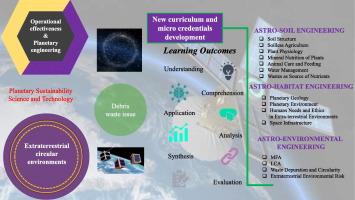行星可持续性科学与技术:整合空间探索的天体土壤、天体环境工程和天体栖息地工程
IF 8
1区 环境科学与生态学
Q1 ENVIRONMENTAL SCIENCES
引用次数: 0
摘要
本文探讨了行星可持续性科学与技术的跨学科领域,将环境科学、工程和可持续性原则相结合,以确保人类在地外环境中居住的长期可行性。该研究引入了一个结合空间环境工程、空间土壤工程和空间人居工程的新框架,重点关注废物回收和循环资源回收。通过这种有凝聚力的方法,本文提出了管理废物碎片的创新方法(因为有35,750个碎片物体,有超过640个破碎和碰撞记录,有900,000个碎片物体大于1厘米)废物回收,资源回收,栖息地可持续性,强调需要新的教育课程,为下一代工程师做好准备空间探索和活动。此外,还讨论了人类可持续地向空间扩展所必需的伦理、技术和法律方面的考虑。通过基于PRISMA框架的系统文献综述,检索了来自Scopus、European Space Agency、NASA等数据库的218篇文献和数据。利用VOS-viewer软件进行文献计量分析,定义关键主题和趋势,利用235个与空间碎片相关的关键词和213个与空间垃圾相关的关键词生成网络可视化关键词图,表明工程教育与空间教育、行星科学和空间研究以及循环经济原则高度相关。论文提出了一个基于Bloom分类法的新课程框架,以定义学习目标和成果,考虑到植物生理学、植物的矿物质营养、作为营养来源的太空废物、物质流分析、地外环境风险、碎片收集系统、行星地质学和生命支持系统、人工智能、人类需求和伦理、地外水和循环废物管理等模块。此外,突出和建议创新技术,例如先进的回收系统和水和燃料生产的就地资源利用,以及促进循环模式和可持续做法。本文章由计算机程序翻译,如有差异,请以英文原文为准。

Planetary sustainability science and technology: Integrating Astro-soil, Astro-environmental engineering and Astro-habitat engineering for space exploration
This paper explores the interdisciplinary field of Planetary Sustainability Science and Technology, integrating environmental science, engineering, and sustainability principles to ensure the long-term viability of human settlements in extraterrestrial environments. The study introduces a novel framework combining Astro-Environmental Engineering, Astro-Soil Science, and Astro-Habitat Engineering, with an emphasis on waste recycling, circular resource recovery. Through this cohesive method, the paper proposed innovative approaches to manage waste debris (as there are >35,750 debris objects with over 640 breaks ups and collision which have been recorded and with 900,000 debris objects larger than 1 cm) waste recycling, resource recovery, habitat sustainability, stressing the need for new educational curricula to prepare the next generation of engineers for space exploration and activities. Moreover, the ethical, technological and legal consideration necessary for sustainable human expansion into space have been addressed. Through a systematic literature, review based on PRISMA framework we retrieve 218 references and data from database such as Scopus, European Space Agency, NASA. Bibliometric analysis was performed using VOS-viewer software defining key themes and trends, generating keywords maps for network visualization using 235 keywords related with space debris and 213 keywords related with space trash indicated that engineering education is hyperconnected with space education, planetary science and space research as well as with circular economy principles. The paper proposed a new curriculum framework based on Bloom's taxonomy to defined learning objectives and outcomes considering modules such as plant physiology, mineral nutrition of plants, space waste as source of nutrients, material flow analysis, extraterrestrial environmental risk, debris collection systems, planetary geology and life support systems, artificial intelligence, human needs and ethics, extraterrestrial water and circular waste management. In addition, highlight and proposed innovative technologies such as advanced recycling systems and in situ resource utilization for water and fuel production as well as promote circular models and sustainable practices.
求助全文
通过发布文献求助,成功后即可免费获取论文全文。
去求助
来源期刊

Science of the Total Environment
环境科学-环境科学
CiteScore
17.60
自引率
10.20%
发文量
8726
审稿时长
2.4 months
期刊介绍:
The Science of the Total Environment is an international journal dedicated to scientific research on the environment and its interaction with humanity. It covers a wide range of disciplines and seeks to publish innovative, hypothesis-driven, and impactful research that explores the entire environment, including the atmosphere, lithosphere, hydrosphere, biosphere, and anthroposphere.
The journal's updated Aims & Scope emphasizes the importance of interdisciplinary environmental research with broad impact. Priority is given to studies that advance fundamental understanding and explore the interconnectedness of multiple environmental spheres. Field studies are preferred, while laboratory experiments must demonstrate significant methodological advancements or mechanistic insights with direct relevance to the environment.
 求助内容:
求助内容: 应助结果提醒方式:
应助结果提醒方式:


